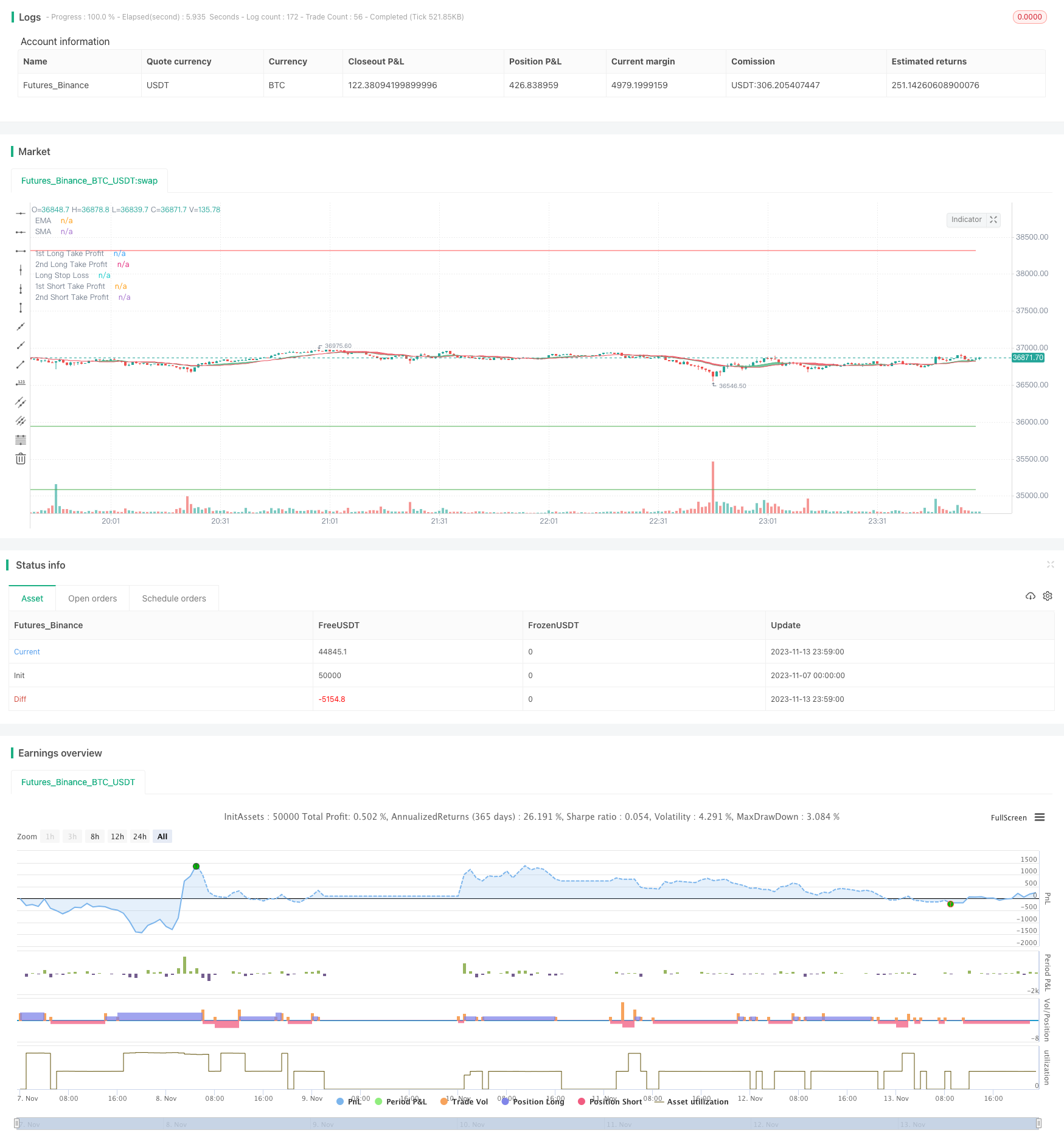
概述
该策略运用双RSI指标进行长短双向交易,同时结合均线系统判断趋势方向,属于双RSI量化策略。策略首先利用RSI指标判断多空信号,再结合均线判断趋势方向决定做多做空,属于典型的趋势跟踪策略。
原理分析
双RSI量化策略主要运用双时间周期RSI指标进行交易信号判断。策略首先设置两个RSI参数,一个较长周期作为主交易判断,一个较短周期作为辅助过滤。当较长周期RSI线下破过卖线时产生做多信号,当短周期RSI线上破过买线时产生做空信号,形成双RSI指标的长短交叉交易机会。
为过滤假信号,策略还引入SMA和EMA平均线进行趋势判断。只有当短期SMA线上穿长期EMA线时才考虑RSI做多信号,只有短期SMA线下穿长期EMA线时才考虑RSI做空信号,确保双RSI信号与趋势方向一致,避免做反趋势交易。
此外,策略还设置止损止盈逻辑。开仓后会同时下两个不同数量的止盈单,并设定止损位。
优势分析
双RSI量化策略具有以下优势:
双时间周期RSI指标能更准确判断多空信号。长短周期RSI交叉组合,可以过滤掉部分假信号,提高信号质量。
均线系统辅助判断大趋势方向,避免做反趋势交易,可以过滤大部分噪音交易,提高胜率。
灵活的止盈止损机制,可以通过不同的止盈设置获得更高收益,也可以止损来控制风险。
策略交易逻辑简单清晰,容易理解和优化,适合量化交易者学习。
风险分析
尽管双RSI量化策略有一定优势,但也存在以下风险:
RSI指标本身对震荡行情和趋势反转的判断没有效果,策略在这些市场中的交易效果可能不佳。
均线系统虽可过滤小范围噪音,但对中间周期趋势变化的判断效果不佳,可能错过趋势转折点。
止盈止损设置不当可能导致止损过宽或止盈过小,降低策略效果。
大规模做空做多可能导致亏损扩大,需要控制仓位规模。
针对以上风险,可以通过调整RSI参数,引入更先进的趋势和反转指标,优化止盈止损逻辑,以及控制仓位来降低风险。
优化方向
双RSI量化策略可以从以下几个方向进行进一步优化:
尝试不同的参数组合,优化RSI周期参数,找到最佳长短周期RSI指标组合。
测试不同的均线指标,引入MACD等指标判断趋势和反转机会。
优化止盈止损策略,设置追踪止损或移动止盈,让止盈止损更灵活。
增加仓位控制模块,在大周期趋势不同阶段控制做多做空仓位。
增加机器学习模型提升 entries 和 exits 的准确性。
进行回测优化,找到最佳交易品种和时间周期。
总结
双RSI量化策略整体来说是一个典型的趋势跟踪策略。它融合双RSI指标判断交易信号和均线系统过滤噪音的策略思路非常经典和实用。虽然策略也存在一定改进空间,但整体运行逻辑清晰,容易理解和优化。这是一个非常适合量化交易初学者学习和实践的策略。通过 Practice makes perfect 原则,不断对该策略进行优化和迭代,可以获得稳定的交易结果。
/*backtest
start: 2023-11-07 00:00:00
end: 2023-11-14 00:00:00
period: 1m
basePeriod: 1m
exchanges: [{"eid":"Futures_Binance","currency":"BTC_USDT"}]
*/
//@version=4
strategy("Growth Producer", overlay=true, initial_capital = 1000, currency = "USD", pyramiding = 2, commission_type=strategy.commission.percent, commission_value=0.07, default_qty_type = strategy.percent_of_equity, default_qty_value = 100)
//Functions
Atr(p) =>
atr = 0.
Tr = max(high - low, max(abs(high - close[1]), abs(low - close[1])))
atr := nz(atr[1] + (Tr - atr[1])/p,Tr)
/// TREND
ribbon_period = input(19, "Period", step=1)
leadLine1 = ema(close, ribbon_period)
leadLine2 = sma(close, ribbon_period)
p1 = plot(leadLine1, color= #53b987, title="EMA", transp = 50, linewidth = 1)
p2 = plot(leadLine2, color= #eb4d5c, title="SMA", transp = 50, linewidth = 1)
fill(p1, p2, transp = 60, color = leadLine1 > leadLine2 ? #53b987 : #eb4d5c)
// Relative volatility index
length = input(120,"RVI period", minval=1), src = close
len = 14
stddev = stdev(src, length)
upper = ema(change(src) <= 0 ? 0 : stddev, len)
lower = ema(change(src) > 0 ? 0 : stddev, len)
rvi = upper / (upper + lower) * 100
benchmark = input(35, "RVI benchmark", minval=10, maxval=100, step=0.1)
// Plot RVI
// h0 = hline(80, "Upper Band", color=#C0C0C0)
// h1 = hline(20, "Lower Band", color=#C0C0C0)
// fill(h0, h1, color=#996A15, title="Background")
// offset = input(0, "Offset", type = input.integer, minval = -500, maxval = 500)
// plot(rvi, title="RVI", color=#008000, offset = offset)
/// MFI input
mfi_source = hlc3
mfi_length = input(19, "MFI Length", minval=1)
mfi_lower = input(15, "MFI Lower level", minval=0, maxval=50)
mfi_upper = input(90, "MFI Higher level", minval=50, maxval=100)
// MFI
upper_s = sum(volume * (change(mfi_source) <= 0 ? 0 : mfi_source), mfi_length)
lower_s = sum(volume * (change(mfi_source) >= 0 ? 0 : mfi_source), mfi_length)
mf = rsi(upper_s, lower_s)
// mfp = plot(mf, color=color.new(color.gray,0), linewidth=1)
// top = hline(mfi_upper, color=color.new(color.gray, 100), linewidth=1, editable=false)
// bottom = hline(mfi_lower, color=color.new(color.gray,100), linewidth=1, editable=false)
// hline(0, color=color.new(color.black,100), editable=false)
// hline(100, color=color.new(color.black,100), editable=false)
// Breaches
// b_color = (mf > mfi_upper) ? color.new(color.red,70) : (mf < mfi_lower) ? color.new(color.green,60) : na
// bgcolor(HighlightBreaches ? b_color : na)
// fill(top, bottom, color=color.gray, transp=75)
// Initial inputs
Act_RSI_VWAP_long = input(true, "RSI VOLUME WEIGHTED AVERAGE PRICE LONG")
RSI_VWAP_length_long = input(16, "RSI-VWAP LENGTH LONG")
RSI_VWAP_overSold_long = input(13, "RSI-VWAP OVERSOLD LONG", type=input.float)
RSI_VWAP_overBought_long = input(68, "RSI-VWAP OVERBOUGHT LONG", type=input.float)
Act_RSI_VWAP_short = input(true, "RSI VOLUME WEIGHTED AVERAGE PRICE SHORT")
RSI_VWAP_length_short = input(14, "RSI-VWAP LENGTH SHORT")
RSI_VWAP_overSold_short = input(7, "RSI-VWAP OVERSOLD SHORT", type=input.float)
RSI_VWAP_overBought_short = input(68, "RSI-VWAP OVERBOUGHT SHORT", type=input.float)
// RSI with VWAP as source
RSI_VWAP_long = rsi(vwap(close), RSI_VWAP_length_long)
RSI_VWAP_short = rsi(vwap(close), RSI_VWAP_length_short)
// Plot Them Separately.
// Plotting LONG, Put overlay=false
// r=plot(RSI_VWAP_long, color = RSI_VWAP_long > RSI_VWAP_overBought_long ? color.red : RSI_VWAP_lnog < RSI_VWAP_overSold_long ? color.lime : color.blue, title="rsi", linewidth=2, style=plot.style_line)
// h1=plot(RSI_VWAP_overBought_long, color = color.gray, style=plot.style_stepline)
// h2=plot(RSI_VWAP_overSold_long, color = color.gray, style=plot.style_stepline)
// fill(r,h1, color = RSI_VWAP_long > RSI_VWAP_overBought_long ? color.red : na, transp = 60)
// fill(r,h2, color = RSI_VWAP_long < RSI_VWAP_overSold_long ? color.lime : na, transp = 60)
// Plotting SHORT, Put overlay=false
// r=plot(RSI_VWAP_short, color = RSI_VWAP_short > RSI_VWAP_overBought_short ? color.red : RSI_VWAP_short < RSI_VWAP_overSold_short ? color.lime : color.blue, title="rsi", linewidth=2, style=plot.style_line)
// h1=plot(RSI_VWAP_overBought_short, color = color.gray, style=plot.style_stepline)
// h2=plot(RSI_VWAP_overSold_short, color = color.gray, style=plot.style_stepline)
// fill(r,h1, color = RSI_VWAP_short > RSI_VWAP_overBought_short ? color.red : na, transp = 60)
// fill(r,h2, color = RSI_VWAP_short < RSI_VWAP_overSold_short ? color.lime : na, transp = 60)
/////// STRATEGY Take Profit / Stop Loss ////////
////// LONG //////
long_tp1_inp = input(3.3, title='Long Take Profit 1 %', step=0.1)/100
long_tp1_qty = input(15, title="Long Take Profit 1 Qty", step=1)
long_tp2_inp = input(12, title='Long Take Profit 2%', step=0.1)/100
long_tp2_qty = input(100, title="Long Take Profit 2 Qty", step=1)
long_sl_inp = input(3.3, title='Long Stop Loss %', step=0.1)/100
long_take_level_1 = strategy.position_avg_price * (1 + long_tp1_inp)
long_take_level_2 = strategy.position_avg_price * (1 + long_tp2_inp)
long_stop_level = strategy.position_avg_price * (1 - long_sl_inp)
////// SHORT //////
short_tp1_inp = input(3.2, title='Short Take Profit 1 %', step=0.1)/100
short_tp1_qty = input(20, title="Short Take Profit 1 Qty", step=1)
short_tp2_inp = input(5.5, title='Short Take Profit 2%', step=0.1)/100
short_tp2_qty = input(100, title="Short Take Profit 2 Qty", step=1)
short_sl_inp = input(3.2, title='Short Stop Loss %', step=0.1)/100
short_take_level_1 = strategy.position_avg_price * (1 - short_tp1_inp)
short_take_level_2 = strategy.position_avg_price * (1 - short_tp2_inp)
short_stop_level = strategy.position_avg_price * (1 + short_sl_inp)
///Strategy_Conditions
/// LONG ///
entry_long =(crossover(RSI_VWAP_long, RSI_VWAP_overSold_long) and leadLine2<leadLine1) or (crossunder(mf,mfi_lower) and leadLine2<leadLine1)
entry_price_long=valuewhen(entry_long,close,0)
exit_long =crossunder(RSI_VWAP_long, RSI_VWAP_overBought_long)
/// SHORT ///
entry_short =crossunder(RSI_VWAP_short, RSI_VWAP_overBought_short) and leadLine2>leadLine1 or (crossover(mf,mfi_upper) and leadLine2>leadLine1)
entry_price_short=valuewhen(entry_short,close,0)
exit_short =crossover(RSI_VWAP_short, RSI_VWAP_overSold_short)
////// BACKTEST PERIOD ///////
testStartYear = input(2019, "Backtest Start Year")
testStartMonth = input(1, "Backtest Start Month")
testStartDay = input(1, "Backtest Start Day")
testPeriodStart = timestamp(testStartYear,testStartMonth,testStartDay,0,0)
testStopYear = input(2020, "Backtest Stop Year")
testStopMonth = input(12, "Backtest Stop Month")
testStopDay = input(31, "Backtest Stop Day")
testPeriodStop = timestamp(testStopYear,testStopMonth,testStopDay,0,0)
testPeriod() => true
if testPeriod()
if strategy.position_size == 0 or strategy.position_size > 0 and rvi>benchmark
strategy.entry("long", true, when = entry_long, comment="Insert Enter Long Comment")
strategy.exit("TP1","long", qty_percent=long_tp1_qty, limit=long_take_level_1, stop=long_stop_level)
strategy.exit("TP2","long", qty_percent=long_tp2_qty, limit=long_take_level_2, stop=long_stop_level)
strategy.close("long", when=exit_long, comment = "Insert Exit Long Comment")
if strategy.position_size == 0 or strategy.position_size < 0 and rvi>benchmark
strategy.entry("short", false, when = entry_short, comment="Insert Enter Short Comment")
strategy.exit("TP1","short", qty_percent=short_tp1_qty, limit=short_take_level_1, stop=short_stop_level)
strategy.exit("TP2","short", qty_percent=short_tp2_qty, limit=short_take_level_2, stop=short_stop_level)
strategy.close("short", when=exit_short, comment = "Insert Exit Short Comment")
// LONG POSITION
plot(strategy.position_size > 0 ? long_take_level_1 : na, style=plot.style_linebr, color=color.green, linewidth=1, title="1st Long Take Profit")
plot(strategy.position_size > 0 ? long_take_level_2 : na, style=plot.style_linebr, color=color.green, linewidth=1, title="2nd Long Take Profit")
plot(strategy.position_size > 0 ? long_stop_level : na, style=plot.style_linebr, color=color.red, linewidth=1, title="Long Stop Loss")
// SHORT POSITION
plot(strategy.position_size < 0 ? short_take_level_1 : na, style=plot.style_linebr, color=color.green, linewidth=1, title="1st Short Take Profit")
plot(strategy.position_size < 0 ? short_take_level_2 : na, style=plot.style_linebr, color=color.green, linewidth=1, title="2nd Short Take Profit")
plot(strategy.position_size < 0 ? short_stop_level : na, style=plot.style_linebr, color=color.red, linewidth=1, title="Long Stop Loss")